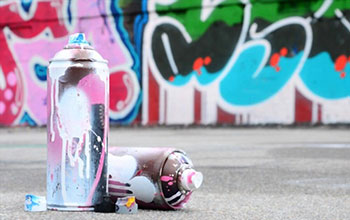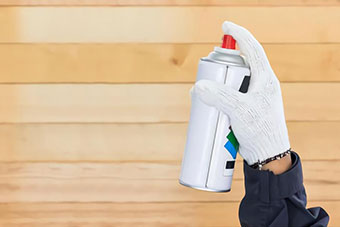Spray paint on walls can ruin the interior, or exterior, design look you are trying to achieve. If you discover spray paint on your walls there are a few things you can do to eliminate the unwanted substance. How you remove the paint will be determined by the wall surface and the paint variety
Supplies You Will Need To Remove Spray Paint From Walls
- Paint remover or graffiti remover
- Paint brush (cheap kind)
- Scraper
- Sandpaper
- Sander
- Stiff bristled scrub brush
- Hand-held broom to brush away debris particles
- Possible bucket of water and sponge
- Disposable gloves
- Mask or respirator
How to Remove Spray Paint From Walls Surfaces

Removing Spray Paint from Concrete or Brick Walls
The most common surface material to get unwanted spray paint on it is the concrete or brick of exterior walls. All too often vandals or street artists will use spray paint to write on or decorate exterior walls on businesses, and public buildings. They will also tag privately owned buildings with their street art.
Removing the spray paint is possible, but I am going to warn you that it takes a lot of determination and elbow grease to completely erase the color from the surface. follow the detailed guide.
Step 1: Your first step is going to be shopping for graffiti remover that is verified to work on concrete, brick, and masonry surfaces. Read the directions on the container very carefully.
Step 2: While wearing protective gloves and a respirator or face mask apply the graffiti remover using the paintbrush. You want to apply a thick coating of the remover.
Step 3: Allow the remover to sit on top of the unwanted paint according to the manufacturer’s instructions on the container. Most removers have to sit on top of the paint for a period of 15 to 30 minutes.
Step 4: When the suggested waiting time is up you will take the scraper and work along the edges of the area of unwanted paint to determine if the paint has been loosened. If you do see evidence that the unwanted paint is beginning to liquefy, or break adherence then you can scrape the entire area, or use the stiff-bristled scrub brush and vigorously scrub the area.
Step 5: Use the sponge and the bucket of water to rinse away the particulates of paint and the graffiti remover residue.
Step 5: Check the surface carefully for evidence of paint that did not come loose. Repeat steps 2-5 until the unwanted color is wholly eradicated.
Removing Spray Paint from Metal Walls

Metal walls also see a lot of graffiti and unwanted spray paint. The sides of metal buildings, boxcars on trains, and other metal surfaces are often targeted by street artists armed with spray paint cans.
Removing the unwanted paint from metal is similar to removing it from concrete or brick surfaces, except the paint thinner or graffiti remover you select must be approved for metal. Some harsh chemicals will damage or remove the protective coating on the metal and allow the metal to rust or corrode more quickly. Follow step-by-step methods.
Step 1: Your first step is going to be shopping for a graffiti remover that is verified to work on metal surfaces. Read the directions on the container very carefully. You want to remove the paint and do not want to damage the coating on the metal.
Step 2: While wearing protective gloves and a respirator or face mask apply the graffiti remover using the paintbrush. You want to apply a thick coating of the remover.
Step 3: Allow the remover to sit on top of the unwanted paint according to the manufacturer’s instructions on the container. Do not let the graffiti remover or paint remover you apply dry on the surface. That will make removal more difficult and will likely create a higher risk of damaging the material. Most removers have to sit on top of the paint for a period of 15 to 30 minutes.
Step 4: When the suggested waiting time is up you will take the scraper and work along the edges of the area of unwanted paint to determine if the paint has been loosened. If you do see evidence that the unwanted paint is beginning to liquefy, or break adherence then you can scrape the entire area, or use the stiff-bristled scrub brush and vigorously scrub the area.
Step 5: Use the sponge and the bucket of water to rinse away the particulates of paint and the graffiti remover residue.
Step 6: Check the surface carefully for evidence of paint that did not come loose. Repeat steps 2-5 until the unwanted color is wholly eradicated. You will want to use a clean dry cloth to dry the metal before re-applying the remover.
Removing Spray Paint from Wooden Walls

Spray paint on wooden walls does happen. Getting the unwanted paint off is different than removing the paint from concrete or even metal surfaces. On wooden surfaces, if your paint thinner or graffiti remover fails to get the paint off you can bring out the sander, and some rough sandpaper and sand the paint away.
Step 1: Follow the same steps as listed above if you are using a paint or graffiti remover.
Step 2: If the paint remover does not get the paint off then switch to the sander.
Step 3: Make sure the board is completely dry before trying to sand it.
Step 4: Use coarse grit sandpaper on your electric sander, or simply use a sheet of coarse grit sandpaper. Sand the paint by working with the grain of the wood, and be careful because you can sand the wood too thin.
Step 5: Dust off the particulates left by the sandpaper, and repeat the process until the paint is gone.
Removing Spray Paint from Sheetrock Walls
I am sorry to say that when unwanted spray paint has been applied to sheetrock or similar wall covering the only method of removal is a cover-up. You are going to need to lightly sand the area to remove as much paint as possible and then you need to cover the surface with a quality primer that can hide stains and marks. When you paint over the primer you will cover up the unwanted paint so no one knows it is there.
Final Thoughts
Unwanted spray paint can be a real pain to get rid of. Your best options are to take your time, prepare for some hard work, and be patient with yourself. It may take several tries before you get all of the unwanted paint off the surface.
